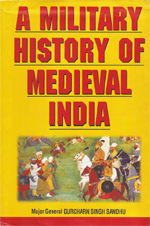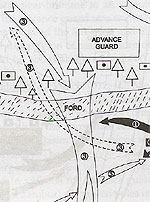By Manoj E. Govindan
Posted on 23 Nov 2003
"A Military History of Medieval India" by Major Gen. Gurcharn Singh Sandhu is a good source of reference on the military history of the Indian Subcontinent from the 11th to 18th Century. Wargamers will find the author's use of diagrams to illustrate battles, his detailed descriptions of army compositions and orders of battle very useful. The narration in general and of battles in particular is pleasant and absorbing even for the casual reader. The observations made by the author in his critiques of various battles are subjective. However Sandhu does meticulously present the facts and events beforehand.
- A Military History of Medieval India by Major Gen. Gurcharn Singh Sandhu
- Hardcover: 887 Pages
- Publisher: Vision Books; (January 2003)
- ISBN: 8170945259
- USD 60.00 (INR 1000.00)
The Medieval Ages continue to attract the wargamer through the decades and there is a steady stream of interesting publications which focus on the age of chivalry. And yet there are very few publications which dwell extensively on the Indian Subcontinent and central Asia. Professional soldier and self professed history buff Major General (Retd.) Gurcharn Singh Sandhu has taken it upon himself to address the dearth of books on the subcontinent's military history. The author explains the source of his inspiration early in the book "In any case, having had to study the military history of Europe and the United States during my service I keenly felt the absence of any literature dealing with the country's own military history" This is a sentiment which most Indian wargamers share.

Sandhu has chosen to deviate from sticking to the conventional time definition of the medieval ages, choosing instead to define the period in question as one that covers the "...military system brought into the country by Turkish Invaders from Central Asia, its interaction with the indigenous system and its subsequent development". Consequently Sandhu focuses on the 11th through 18th centuries of the Subcontinent's military history. Sandhu refrains from making the distinction between the medieval and renaissance periods; instead he treats the military history of the region from 11th through 18th century as a continuum.
The author's military background perhaps explains the emphasis Sandhu attributes to Orders Of Battle (OOBs) and his detailed narration of battles and campaigns. The book makes intelligent use of diagrams to explain formations and to aid descriptions of battles. Sandhu has not spared any effort in detailing military formations as well as the composition and logistic aspects of armies of the era. These are detailed enough to satisfy the scenario designer and at the same time interesting enough for the casual reader.
Sandhu takes a refreshingly objective look at the pivotal events of the subcontinent's history. Indian writers who write on Indian history tend to focus on myth and legend at the expense of objectivity and facts. Their explanations are often coloured by their view of history. Political, nationalist, racial and personal views and prejudices take precedence over the need to present facts as they are known. This leads to exaggerations and shortcomings in the narrative, thereby rendering a distorted and unreliable picture of "history". Logic takes a back seat and the reader is forced to look to other resources or theorise on his own on the subject matter. True, Sandhu does on occasion present his own conclusions and views in the book. But in all fairness it must be noted that he does so after presenting the facts and describing the events quite objectively. Sandhu passionately comments on the various invasions of the Indian Subcontinent and their effect on the course of history. However neither do these stand in the way of the narrative nor do they assume the form of "patriotic" rants.
The first chapter Ancient India gives the reader some background on the military theory and history pertaining to the late Vedic period. It ends with a briefing on Northern India at the end of the Tenth century. Surprisingly for a prologue type of chapter, there is quite detailed information on the various battle formations used by the military powers of the time including the Mauryas. The chapter also explains how cavalry gained ascendancy over Elephants as the premier arm of battle.

Chapters two through twenty nine tackle the subject topic in earnest. The invasions of Mahmud of Ghazni and the Ghaznavid military system have been given a whole chapter. The events concerning Ghazni and the destruction of the Somnath temple have been at the center of many a heated debate of late. Contrary to the present trend to potiticise the issue, Sandhu prudently abstains from distorting the facts for political correctness or diplomacy. In keeping the promise he makes in the prologue Sandhu avoids analysing the political history of the time. Just enough of the day's politics finds mention as is needed to coherently explain the military history. While it is arguable that the political and military history are inseparable, I am inclined to agree with the author's stated position that the political history has recived ample coverage in the past and is best left out as far as possible.
Historical anecdotes abound in the book. The thousand musketeers from Kalpi who walked away from one of Akbar's successful sieges by pretending to be Mughals come to mind. The story goes that they shepherded their wives and children in chains ahead of the column together with their belongings as "booty" for all to see!
Illustrations are simple and to the point. A map from the book, for the Battle of Dulambpur 1612, is reproduced here. While only of peripheral interest to the casual reader, wargamers should find the maps quite useful. Towards the very end of the book General Sandhu has taken the oppurtunity to express his views on topics such as political control of the armed forces. Under such headings as "Mistrust of the Top Brass of the Defence Services", he dwells on the topics which are not core to the book. Wargamers can safely skip these.
The book is absorbing and does not put off the reader in spite of its 800+ pages. Bibliography is extensive, though a chapter wise listing of references would have helped. The quality of printing is not bad but does have room for improvement particularly considering the fairly high Indian pricing. The book is strongly recommended to all those interested in the military history of medieval India.
Where to Buy the Book
Amazon lists this book but it is currently not available. If you are in India, you might visit The Strand Bookstall in Bombay or Bangalore. You could also write to the publishers directly at the following address:
Vision Books Pvt. Ltd.
24 Feroze Gandhi Road, Lajpat Nagar-III,
New Delhi-110024, India
Thanks to Duncan Head for pointing out that Vedams Books also are offering the book online.